
Bed Bugs
[Cimex hemipterus] [Cimex lectularius]
Causal Agents
The two species of bed bugs (Insecta: Hemiptera: Cimicidae) usually implicated in human infestations are Cimex lectularius and C. hemipterus. Although rare, humans may become incidental hosts of Cimex species of bats and birds.
Life Cycle

Adults and all nymphal stages of Cimex spp. need to take blood meals from warm-blooded hosts, which are typically humans for C. lectularius and C. hemipterus, although other mammals and birds can be utilized in the absence of a human host. Female bed bugs lay about five eggs  daily throughout their adult lives in a sheltered location (mattress seams, crevices in box springs, spaces under baseboards, etc). Eggs hatch in about 4-12 days into first instar nymphs
daily throughout their adult lives in a sheltered location (mattress seams, crevices in box springs, spaces under baseboards, etc). Eggs hatch in about 4-12 days into first instar nymphs  which must take a blood meal before molting to the next stage. The bugs will undergo five nymphal stages (
which must take a blood meal before molting to the next stage. The bugs will undergo five nymphal stages ( ,
,  ,
,  ,
,  ,
,  ), each one requiring a blood meal before molting to the next stage, with the fifth stage molting into an adult
), each one requiring a blood meal before molting to the next stage, with the fifth stage molting into an adult  . Nymphs, although lacking wing buds, resemble smaller versions of the adults. Nymphs and adults take about 5-10 minutes to obtain a full blood meal. The adults may take several blood meals over several weeks, assuming a warm-blooded host is available. Mating occurs off the host and involves a unique form of copulation called ‘traumatic insemination’ whereby the male penetrates the female’s abdominal wall with his external genitalia and inseminates into her body cavity. Adults live 6-12 months and may survive for long periods of time without feeding.
. Nymphs, although lacking wing buds, resemble smaller versions of the adults. Nymphs and adults take about 5-10 minutes to obtain a full blood meal. The adults may take several blood meals over several weeks, assuming a warm-blooded host is available. Mating occurs off the host and involves a unique form of copulation called ‘traumatic insemination’ whereby the male penetrates the female’s abdominal wall with his external genitalia and inseminates into her body cavity. Adults live 6-12 months and may survive for long periods of time without feeding.
Geographic Distribution
Cimex lectularius is cosmopolitan in distribution; C. hemipterus is distributed in the tropics and sub-tropics
Clinical Presentation
Although bed bugs have been found naturally-infected with blood-borne pathogens, they are not effective vectors of disease. The primary medical importance is inflammation associated with their bites (due to allergic reactions to components in their saliva)
Cimex lectularius.
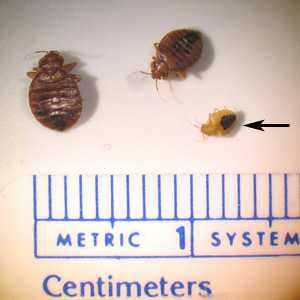
Figure A: Two adults and one nymph (arrow) of C. lectularius, collected in a hotel in urban Georgia.
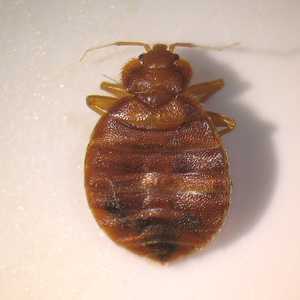
Figure B: Close-up of one of the adults in Figure A.
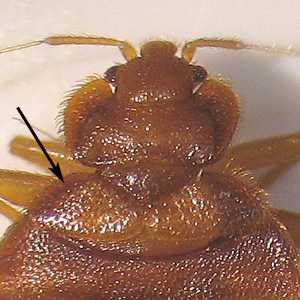
Figure C: Higher magnification of the specimen in Figure B. Note the reduced forewings (arrow).
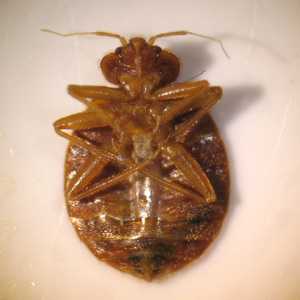
Figure D: Ventral view of the specimen in Figure B.
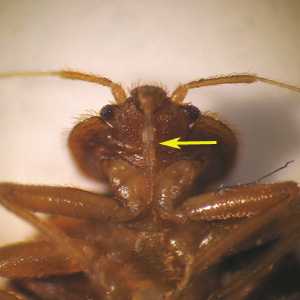
Figure E: Higher magnification of the specimen in Figure D, showing a close-up of the typical hemipteran piercing-sucking mouthparts (arrow).

Figure E: Nymph of C. lectularius. The blue marks represent 1 mm.
Laboratory Diagnosis
The inflammatory reaction to the bites is not diagnostic specifically for bed bugs, and confirmation of a bed bug bite or infestation is best achieved by identification of adults or nymphs collected in sheltered areas near where the patient was bitten. Bed bugs possess stink glands and emit a distinctive odor; homes or motel/hotel rooms with heavy infestations may have this odor.
Treatment Information
Minimal symptomatic treatment and good hygiene to prevent itching and secondary infections are usually sufficient treatment for most cases of bed bug bites.
A wide range of empirical treatments, including antibiotics, antihistamines, topical and oral corticosteroids, and epinephrine have been used for bite reactions with varying results. Treatment options for cutaneous and systemic reactions from bed bug bites have not been evaluated in clinical trials and there is no evidence that outcomes differ significantly from those receiving no treatment.
In more extensive or severe cases, topical steroid creams with or without systemic anti-H1 receptor antihistaminics may be given. Topical antiseptics or antibiotics as well as systemic antibiotics may be needed in the case of secondary infection.
References
- Goddard J, deShazo R, Bed bugs (Cimex lectularius) and clinical consequences of their bites. JAMA 2009;301(13):1358-66.
- Thomas I, Kihiczak G, Schwartz R. Bedbug bites: a review. Int J Dermatol 2004;43(6):430-3.
- Burnett JW, Calton GJ, Morgan RJ. Bedbugs. Cutis 1986;38:20.
- Honig PJ. Arthropod bites, stings, and infestations: their prevention and treatment. Dermatol Pediatr 1986;3:189–97.
DPDx is an education resource designed for health professionals and laboratory scientists. For an overview including prevention and control visit www.cdc.gov/parasites/.
- Page last reviewed: May 3, 2016
- Page last updated: May 3, 2016
- Content source:
- Global Health – Division of Parasitic Diseases and Malaria
- Notice: Linking to a non-federal site does not constitute an endorsement by HHS, CDC or any of its employees of the sponsors or the information and products presented on the site.
- Maintained By:


 ShareCompartir
ShareCompartir